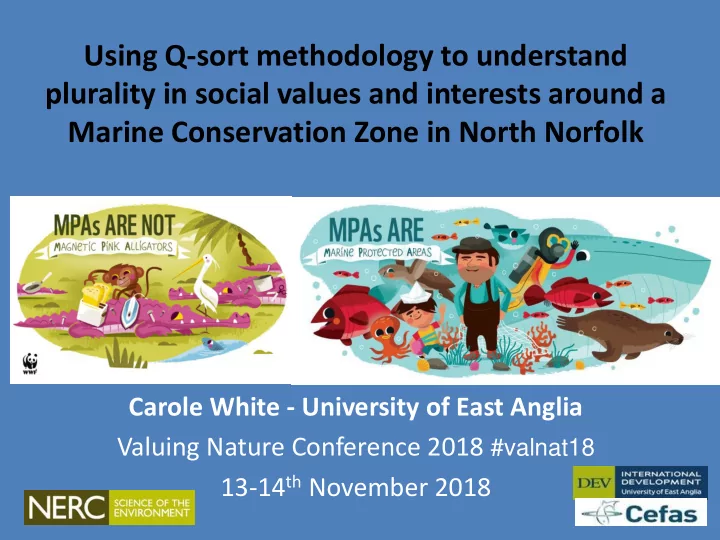

Using Q-sort methodology to understand plurality in social values and interests around a Marine Conservation Zone in North Norfolk Carole White - University of East Anglia Valuing Nature Conference 2018 #valnat18 13-14 th November 2018
Research aims • To understand how different people living and working near the North Norfolk coast value it • Collaborate with and contribute to the Marine Conservation Society Agents of Change project on stakeholder engagement & the Cromer Shoal Marine Conservation Zone • Test out how useful a Q-sort method is to demonstrate different values to decision-makers • Contribute learnings from this methodology to the Marine Pioneer project in Suffolk
Research & Policy Context – Cromer, North Norfolk, East Anglia • MCZ designated in January 2016 and waiting for a management plan – multiple responsibilities involved – not just the IFCA • MCS Agents of Change has been running community workshops to engage stakeholders following their previous Community Voice Method work • Marine Pioneer in Suffolk testing application of a ‘natural capital approach’ in the marine environment • This research builds on my completed PhD (2015) on place identity, resilience and Cromer Crab fishery
Who values what and how? What are the trade-offs?
Chan, K.M., Balvanera, P., Benessaiah, K., Chapman, M., Díaz, S., Gómez- Baggethun, E., Gould, R., Hannahs, N., Jax, K., Klain, S. and Luck, G.W., 2016. Opinion: Why protect nature? Rethinking values and the environment. Proceedings of the National Academy of Sciences , 113 (6), pp.1462-1465.
• Aim of Q-sort is to sample for different viewpoints. Purposeful sampling. Aim is not to be representative of population but focus on range of opinions 22 interviews carried out with fishermen, divers, surfers, conservation volunteers and community activists • 42 statements to sort ranging from: - Personal and collective values – wellbeing - Protection against threats - Local level and national, regional or global - Intrinsic, relational, instrumental - Economic, environmental and social • Examples:
What did I find so far? Many different interpretations, different worldviews….. - Protect nature first: Everything flows from protecting the environment – do this and everything takes care of itself - Protect heritage and culture (linked to crab fishing). Give the coast meaning, a sense of purpose and identity - Stability vs fragility : nature is wild and strong vs nature needs us to help maintain it as it should be – Nature takes care of itself - Local impacts more important than global – even with plastics - Collective wellbeing emphasized over personal wellbeing - Tensions: e.g. increasing learning & education ; fear of too many people taking an interest. Don’t want too many tourists.
Preliminary indications from factor analysis • Factor 1: Place needs protecting against threats: plastic, destructive fishing, industrial development, pollution. Societal good Seals are quite important to protect! But local fishing is too! • Factor 2: The local fishing fleet is the most important reason to protect the area, provides seafood and place identity / chalk is not fragile, fish stocks and biodiversity not threatened, seals do not need protecting! • Factor 3: Individual wellbeing & intrinsic/moral values. Influenced by environmental media discourse: plastics is main reason to protect the marine environment, as well as overfishing.
Why does it matter? Values shape human behaviour and action MCZs are presented as a ‘win - win’: good for the environment and good for people. No-one loses out. Examples of promised expectations often expressed economically : Increased fisheries productivity, Increased recreational/tourism revenue, Protected or enhanced marine life, Community pride, job creation… Is it all possible? Need to understand different perspectives Expect that there will be tensions
Finally - a few challenges to the Natural Capital approach (from this case study) • Cultural values - Generally people do not value the protection nature for their economic benefits – a need for non-monetary valuation tools • Protecting the local place – generally people do not value protection of nature for its contribution to regional, national, European, global commitments – accountability at local level • Societal value - Contributions of nature to individual level wellbeing is not what is most valued – ’citizens’ rather than ’consumers’ • And many trade-offs to consider over scale, time.
Thanks for listening @Carolewhy #valnat18 carole.white@uea.ac.uk
Recommend
More recommend